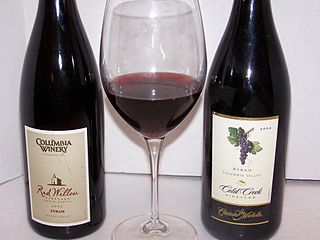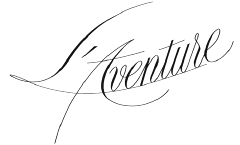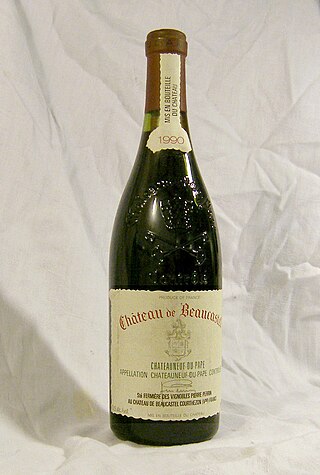Related Research Articles

Marsanne is a white wine grape, most commonly found in the Northern Rhône region. It is often blended with Roussanne. In Savoie the grape is known as grosse roussette. Outside France it is also grown in Switzerland, Spain, Australia, New Zealand, Canada and the United States.

Grenache or Garnacha is one of the most widely planted red wine grape varieties in the world. It ripens late, so it needs hot, dry conditions such as those found in Spain, where the grape is believed originated. It is also grown in the Italian island of Sardinia, the south of France, Australia, and California's Monterey AVA, Paso Robles, and San Joaquin Valley.

The Rhône wine region in Southern France is situated in the Rhône valley and produces numerous wines under various Appellation d'origine contrôlée (AOC) designations. The region's major appellation in production volume is Côtes du Rhône AOC.

Collioure is an Appellation d'Origine Contrôlée (AOC) for French wines situated around the town of Collioure in the Roussillon wine region of France. Red, rosé and a few white wines are produced-the reds from Grenache noir, Mourvèdre, Syrah, Carignan and Cinsaut grapes; the white are made from a blend of Grenache blanc and Grenache gris. The boundaries of the AOC are identical with the Banyuls AOC as many of the grapes grown in Collioure are destined for use in the fortified Vins doux naturels of the region. The grapes that do not get used for Banyuls are then produced as non-fortified still wines under the Collioure AOC.

Châteauneuf-du-Pape is a French wine, an Appellation d'origine contrôlée (AOC) located around the village of Châteauneuf-du-Pape in the Rhône wine region in southeastern France. It is one of the most renowned appellations of the southern part in the Rhône Valley, and its vineyards are located around Châteauneuf-du-Pape and in neighboring villages, Bédarrides, Courthézon and Sorgues, between Avignon and Orange. They cover slightly more than 3,200 hectares or 7,900 acres (32 km2) and produce over 110,000 hectolitres of wine a year, more wine made in this one area of the southern Rhône than in all of the northern Rhône.

McLaren Vale is a wine region in the Australian state of South Australia located in the Adelaide metropolitan area and centred on the town of McLaren Vale about 38 kilometres (24 mi) south of the Adelaide city centre. It is internationally renowned for the wines it produces and is included within the Great Wine Capitals of the World. The region was named after either David McLaren, the Colonial Manager of the South Australia Company or John McLaren (unrelated) who surveyed the area in 1839. Among the first settlers to the region in late 1839, were two English farmers from Devon, William Colton and Charles Thomas Hewett. William Colton established the Daringa Farm and Charles Thomas Hewett established Oxenberry Farm. Both men would be prominent in the early days of McLaren Vale. Although initially the region's main economic activity was the growing of cereal crops, John Reynell and Thomas Hardy planted grape vines in 1838 and the present-day Seaview and Hardy wineries were in operation as early as 1850. Grapes were first planted in the region in 1838 and some vines more than 100 years old are still producing. Today there are more than 95 cellar doors in McLaren Vale. The majority are family-run operations and boutique wineries.

Languedoc-Roussillon wine, including the vin de pays labeled Vin de Pays d'Oc, is produced in southern France. While "Languedoc" can refer to a specific historic region of France and Northern Catalonia, usage since the 20th century has primarily referred to the northern part of the Languedoc-Roussillon région of France, an area which spans the Mediterranean coastline from the French border with Spain to the region of Provence. The area has around 700,000 acres (2,800 km2) under vines and is the single biggest wine-producing region in the world, being responsible for more than a third of France's total wine production. In 2001, the region produced more wine than the United States.

Grenache blanc is a variety of white wine grape that is related to the red grape Grenache. It is mostly found in Rhône wine blends and in northeast Spain. Its wines are characterized by high alcohol and low acidity, with citrus and or herbaceous notes. Its vigor can lead to overproduction and flabbiness. However, if yields are controlled, it can contribute flavor and length to blends, particularly with Roussanne. Since the 1980s, it has been the fifth most widely planted white wine grape in France after Ugni blanc, Chardonnay, Semillon and Sauvignon blanc.

Priorat is a Denominació d'Origen Qualificada (DOQ) for Catalan wines produced in the Priorat county, in the province of Tarragona, in the southwest of Catalonia.

Twisted Oak Winery is a family-owned boutique winery in Vallecito, California specializing in wine made from grape varieties native to the Mediterranean regions of western Europe. The winery is located on a hilltop at 2280 ft above sea level in the foothills of the Sierra Nevada Mountains, and most of the grapes for the wines are sourced from nearby vineyards in Calaveras County. The winery name and logo design are derived from a California Blue Oak tree on the property.

The Rhone Rangers are a group of American winemakers who promote the use of grape varieties from the Rhône Valley. They are mostly based on the West Coast, particularly California, and have created a not-for-profit organization for the promotion of wines containing at least 75% of the 22 Rhône grape varieties. The name is a pun on The Lone Ranger, and was coined by Wine Spectator to describe Randall Grahm for their 1989 April 15 issue, which featured Grahm dressed as the Lone Ranger under the title "The Rhône Ranger" (singular). The name was subsequently used for other winemakers.

L'Aventure, or Stephan Vineyards, is a California wine estate producing red wine blends of the Bordeaux and Rhône grape varieties. The winery is located southwest of Paso Robles, California, along the Pacific Coast in the Santa Lucia Mountain range.

Provence (Provençal) wine comes from the French wine-producing region of Provence in southeast France. The Romans called the area provincia nostra, giving the region its name. Just south of the Alps, it was the first Roman province outside Italy.
Sine Qua Non is a California winery that is known for its wines made from blends of Rhône grape varietals, a very limited production of wines that are difficult to obtain. Each release is allocated and directly sold to a carefully managed mailing list of customers. As of 2018, the wait to join the mailing list was approximately 9 years. The winery is located in Ventura County and was founded in 1993 by Austrian Manfred Krankl, who emigrated to the US in 1980.
Mas Cal Demoura is a wine domaine situated near the village of Jonquières in the Terrasses du Larzac appellation in the north of the Hérault region, Southern France.

Château de Beaucastel is a winery located in the southern part of the Rhône valley in France, which is primarily noted for its Châteauneuf du Pape wines produced in a long-lived style. For its red Châteauneuf du Pape, Beaucastel includes all 13 grape varieties that are traditionally part of the blend, and uses a higher-than-usual proportion of Mourvèdre. The special Vieilles Vignes cuvée of Beaucastel's white Châteauneuf du Pape is a varietal Roussanne wine, which is rare in Rhône and rarer in Châteauneuf du Pape.

Château Golan is an Israeli winery established in 1999, and is one of Israel's most extravagant. It is located in the southern Golan Heights, near the point where the Yarmuk River and wadi Ruqqad meet.

Tablas Creek Vineyard is a California wine estate producing various Rhône-style blends and varietal wine. The winery is located in the Adelaida district west of Paso Robles in the Santa Lucia Mountains, within the Paso Robles AVA. It is an exemplar of the GSM blend, and has been influential in popularizing it in California.

Red Willow Vineyard is a grape-growing estate located in the far western end of Yakima Valley AVA, within the Yakama Indian Reservation. Beginning with their relationship with Columbia Winery and Master of Wine David Lake, grapes from Red Willow have been used to produce some of the most critically acclaimed Washington wines with the vineyard's name regularly being featured on vineyard designated wines. Paul Gregutt, wine writer for the Seattle Times and Wine Enthusiast, list Red Willow as one of the "top ten" vineyards in the entire state.
References
- 1 2 3 Miquel Hudin (2015), Vinologue Priorat, Vinologue, p. 480, ISBN 978-0-983-77185-2
- 1 2 3 Goode, Jamie, wineanorak.com The wines of Sadie Family
- ↑ Robinson, Jancis, jancisrobinson.com (11 August 2009). The virtues of blending
- 1 2 Apple, R.W., The New York Times (22 April 1998). A South African Black On a Road Never Traveled
- 1 2 3 Dixon, Robyn (23 February 2009). "In South Africa, an artist in the vineyard". Los Angeles Times . Malmesbury. Retrieved 10 February 2022.
- ↑ Prial, Frank J., The New York Times (5 June 2002). In South Africa, He Let the Goats Out
- 1 2 Atkin, Tim, decanter.com (8 June 2009). Interview with Eben Sadie
- 1 2 3 Yarrow, Alder, vinography.com (3 October 2008). Sadie Family Wines, Swartland, South Africa
- ↑ James, Tim, Grape (27 September 2009). Columella glows in starlight
- ↑ Molesworth, James, Wine Spectator (30 April 2009). Diversity and Value